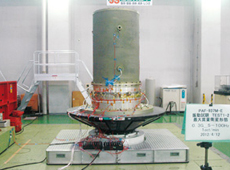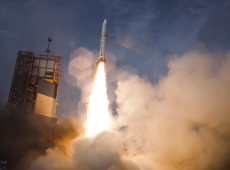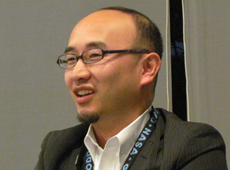
--- What sort of work did you do, exactly?

Vibration test

Third-stage rocket motor case
One of my jobs was to give the satellite a comfortable ride. I made sure the rocket’s fuselage would be able to withstand the shocks and vibrations during launch and the heat, pressure and air resistance during flight. For example, during launch, the sound of the jet of burning fuel that propels the launch vehicle bounces off the ground and makes the rocket body vibrate, putting stress on the satellite. In order to reduce that vibration, we developed a flue – a kind of tunnel – to block the sound. This flue succeeded in reducing the vibrations to less than one-tenth those of the M-V launch vehicle.
--- One-tenth is amazing. The Epsilon’s second and third stages are modified versions of the M-V Launch Vehicle’s upper stages. What sorts of modifications were made?
We made major changes to the motor case where we inject the propellant. The motor case used on the M-V was more than 10 years old, so it was difficult to obtain the materials. So we decided to use a new material – carbon fiber reinforced plastic (CFRP), the strongest material in the world at the time. In addition, we held down costs by simplifying the molding process. I think this turned out well in terms of both performance and cost.
--- What was particularly difficult about the work?
There were two things. One was testing to measure the acoustic environment, which took place at the Noshiro Rocket Testing Center. There, we measure the sound by building a miniature launch pad, which has a different shape than the actual one because of the small motor and certain design issues. Those measurements didn’t quite reach the levels we were going for. We hit our target on our final day of testing. I was so nervous at that time.
The second tough thing was coordinating between organizations and manufacturers. Epsilon was based on two launch vehicles – the M-V and the H-IIA – but those were developed by different organizations: the M-V by the Institute of Space and Astronautical Science (ISAS) and the H-IIA by the National Space Development Agency (NASDA). Each has its own design concept, so it was difficult to figure out how to fit them both into Epsilon. Furthermore, we had to be very careful in handling technological information from competing manufacturers. Much of Epsilon’s body was made by IHI Aerospace, but the parts used to assemble it were made by other companies – Kawasaki Heavy Industries, Mitsubishi Heavy Industries, etc. But IHI Aerospace is also able to make these components, so that makes them competitors. Generally, nobody wants their design info and know-how get out. But to make a rocket highly reliable, you have to share information. It was very hard to coordinate how much information to release, and to exchange all the information properly, without sharing too much. But I think that challenge motivated me.
--- What was the most difficult time before launch?

Launch of the first Epsilon Launch Vehicle (courtesy: JAXA/JOE NISHIZAWA)
The Epsilon Launch Vehicle’s development really got under way after we got a budget for it in 2010, but for the few years before that I was constantly worried, because all we had done was to draw up the new rocket’s concept, and I didn’t know what would come next. That was a tough time. That and the three months prior to launch were difficult. There was a mountain of work to do, and I spent 40 straight days at the Uchinoura launch site without seeing my family. I couldn’t afford to take a break. There were two launch delays during that period, and dealing with them was also really hard. I was working from morning straight into the night. That’s because whenever we found a flaw, we had to see whether the same flaw existed anywhere else in the rocket.
--- You had to review everything?!
That’s right. Pinpointing the location of a flaw and just fixing it in that place is simple, but you have to check every item to see whether the same kind of thing will occur under similar circumstances. For example, the cause of the second postponement was a 0.07-second time lag in signals from the ground to the rocket, but that was merely one of over a thousand checklist items. We had to check all the other items one at a time to make sure no lag would occur. I know that work is necessary, but among our team we said it felt like we had taken on a nasty dare in a game of Truth or Dare... That’s how hard it was.
--- How did you feel on the day of the launch, after you finally solved these problems?
Honestly, I was thinking, “Launch already! I can’t do this anymore!” (Laughs.) I was mentally and physically exhausted, so much so that I thought I couldn’t pick myself up if there was another delay. I was in a daze for a bit after the launch, and I was relieved that it was over and that I could finally go home.
--- What kinds of things did you know you had to make sure to do as the project was underway?
Bringing diverse groups of people together. This was my first time working on developing a rocket, so I had no prior experience or directly relevant skills. There was a lot I still didn’t know about rocket design and testing, and the advice of experienced people was so important. That’s why I personally made sure to bring people with expertise into the project to work on problems I couldn’t solve myself. In addition, I knew that if I just focused on structural subsystems, I would have missed problems in other areas, so I remembered to try to maintain a broad perspective.
--- What is your ideal rocket?

Flue for acoustic noise reduction
A rocket that offers a comfortable ride. Forget for the moment about whether or not we’re actually going to build a manned rocket. If we’re going to try to make a better rocket, then I’d like to make one that flies comfortably enough for people to ride in it.
--- Is making rockets fun?
Yes. I think I keep on doing it because it is fun. To me, rockets themselves are very interesting. They’re like the ultimate toy. Investigating all sorts of things as you’re developing a rocket is so very fun. One of the best things is that you can’t conduct a final test so long as you’re on the ground. With a car, for example, you can test it in the environment where it will be used, but with a rocket you don’t have that opportunity unless you actually try flying it. Instead you imagine that environment, test things as much as possible on the ground, and then build it. Plus, since it’s hard to test a life-size rocket, you split the components up according to their roles, or conduct tests on a miniature model. There’s a gap between the test model and the real thing, so you have to cover that in your design analysis. I think it’s interesting to predict and compensate for things like this.
--- What sorts of upgrades will be added to the second flight of the Epsilon?
Originally there were two Epsilons: one with a basic form with three stages all powered by solid fuel, and another option with a small liquid-propellant engine called a PBS loaded above the third stage, to adjust trajectory. The test model had the latter design, but the second flight won’t have a PBS on board, so we have to make upgrades accordingly. In addition, I think I want to make the second rocket’s payload capacity slightly higher than the test model’s. Fortunately we were able to significantly reduce the vibrations and noise level in the test model, so I’d also like to make the second one a rocket with a really comfortable ride.
--- When you say comfortable ride, do you mean comfortable for the satellite on board?
That’s right. A rocket that’s gentle with the satellite. Soon after I joined JAXA I was put in charge of operating and maintaining experimental equipment for conducting satellite vibration and shock tests. I received a lot of advice and information from satellite people, which helped me understand just how much of an effect the launch environment has on a satellite. I want to make full use of that experience on this next rocket. The effect of vibrations and acoustics is greater with a solid-fuel rocket than with a liquid-propellant rocket, and the launch environment is said to be strenuous, but we were able to reduce the level of sound from the Epsilon test vehicle to a figure close to that of the H-IIA.
--- Do you have a message for young people?

I think it’s important to be perceptive and have a skeptical attitude. My advice is to be curious about many things, and pay attention when you feel something is strange. That, and don’t be dismissive of any doubts you may have. Particularly when we’re young, we often defer to those around us and keep quiet even if we think something is a bit odd. I used to be like that, too, but many times my idea was correct. That’s why I want to encourage young people to summon the courage to express their misgivings.
--- How does the outlook for the future seem to you?
They say we built the Epsilon Launch Vehicle quickly and affordably because we used a lot of existing technology. I think it’s OK to leave almost all the development to private-sector manufacturers if you use existing technology in this fashion. I think as time goes on, JAXA’s presence in this type of project will become smaller. We’re a research and development agency, so I want to work on more radical ideas in the future. However, in order to develop new technologies, we need a good deal of data. For example, for this rocket’s design, we even used test data from a few decades ago, but that type of information will not open up new worlds. We perform new tests so that we can get data for our improved analytical techniques. If we don’t do that, then the basic level of technology will not rise. Such R&D is going to cost money and time no matter what, so of course I think JAXA ought to take on that task, and I hope that I, too, can contribute in that regard. There’s still much, much more we need to do in rocket development!
Associate Senior Engineer, Epsilon Rocket Project Team, Space Transportation Mission Directorate, JAXA
Dr. Ui earned his Ph.D. at the Tokyo Institute of Technology, where he participated in the CubeSat project to develop a miniaturized satellite. He was hired by JAXA in 2005. At JAXA’s Institute of Space and Astronautical Science, he participated in launch-site operations for M-V Launch Vehicles No. 7 and 8, while working on the operation and maintenance of experimental equipment for conducting satellite vibration and shock tests. In 2007, Dr. Ui joined the Epsilon Launch Vehicle team. His work mostly deals with structural and mechanical systems, liquid-propellant systems and the payload interface.
Making good rockets requires more simplicity!
Epsilon Technology: A Link to the Future
Epsilon: A Soft and Comfortable Ride
The Anytime, Anywhere Rocket
Building a Versatile Rocket
